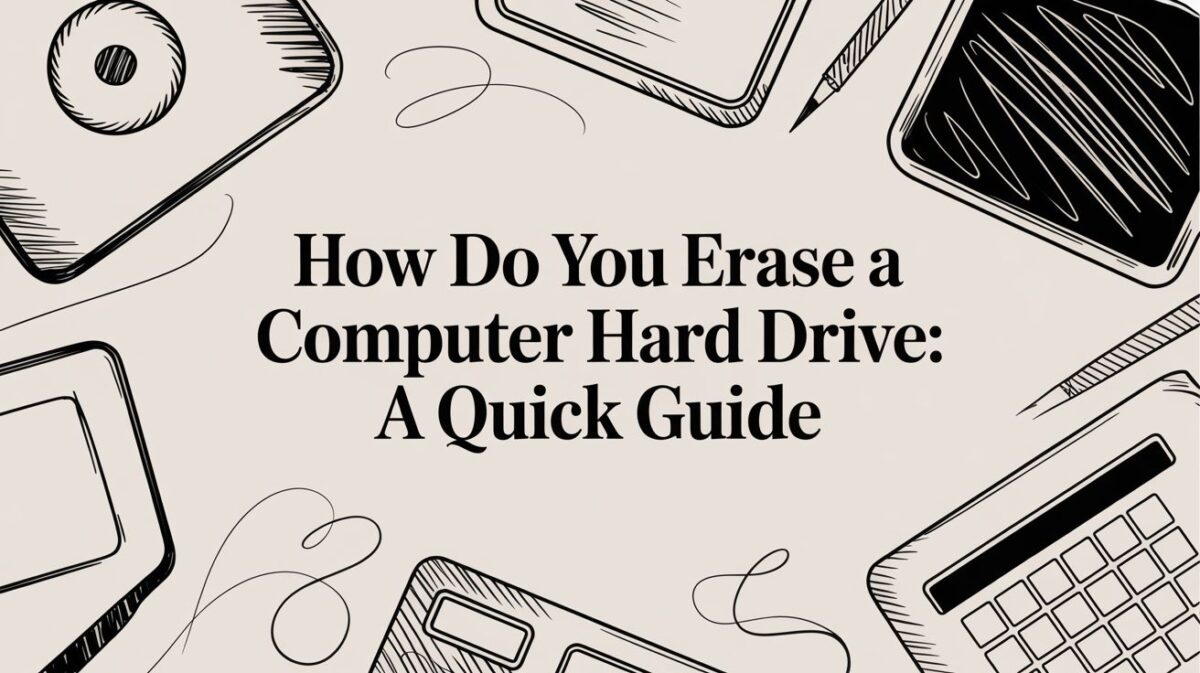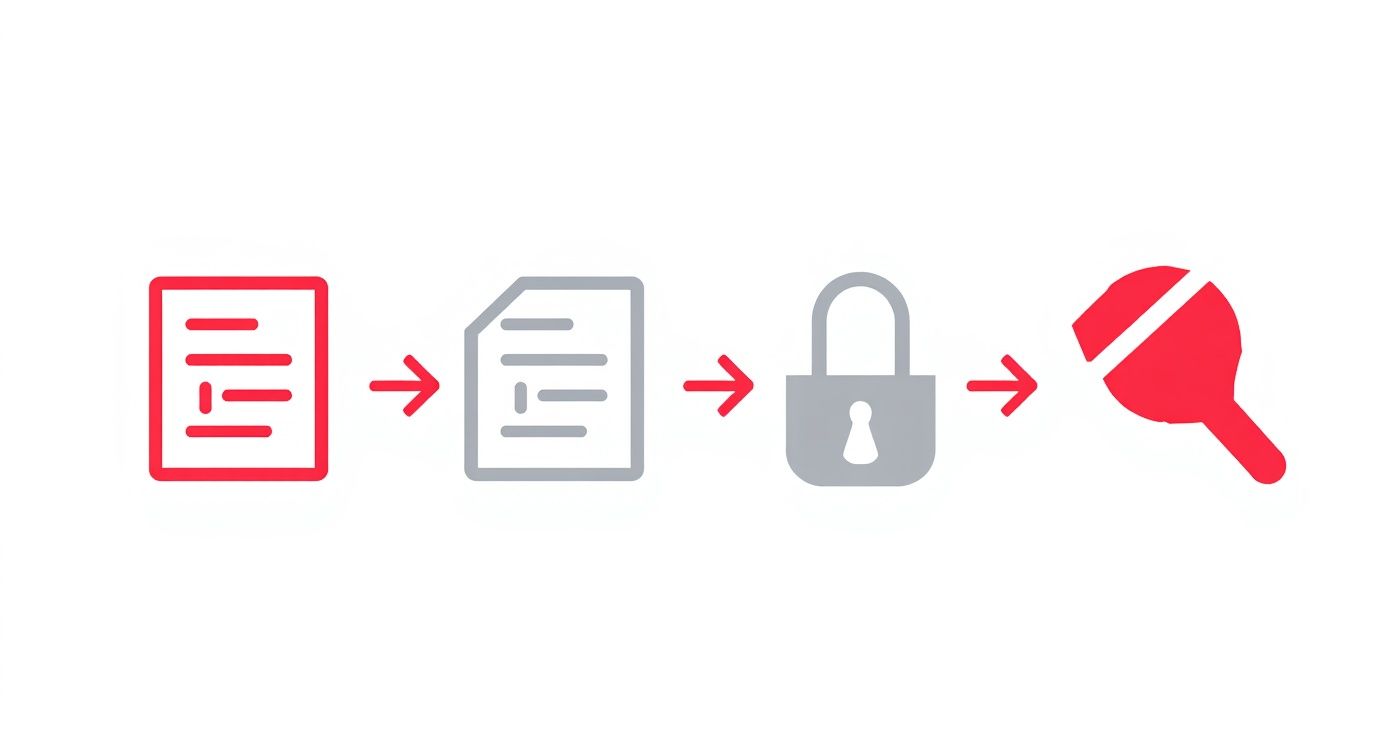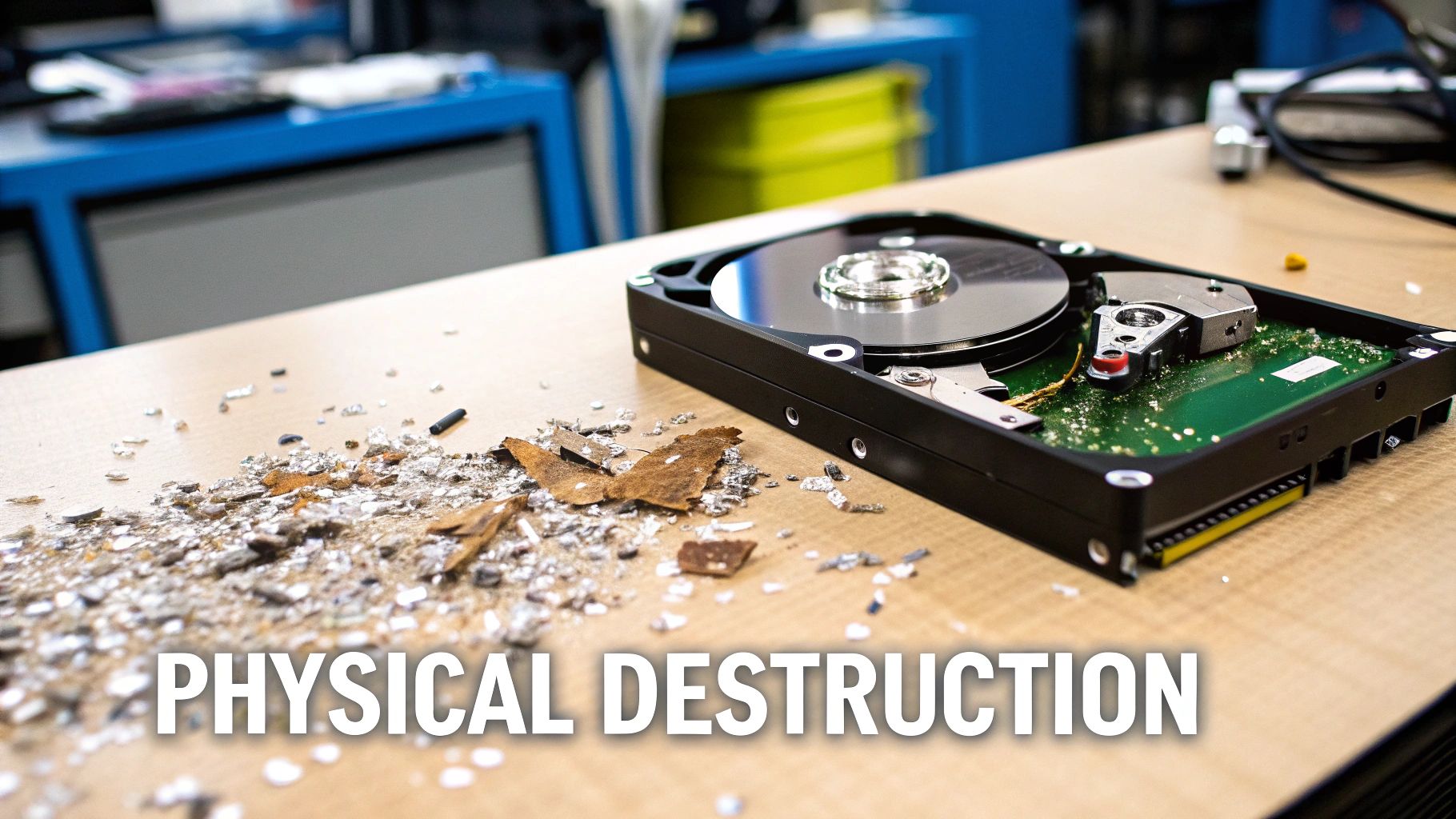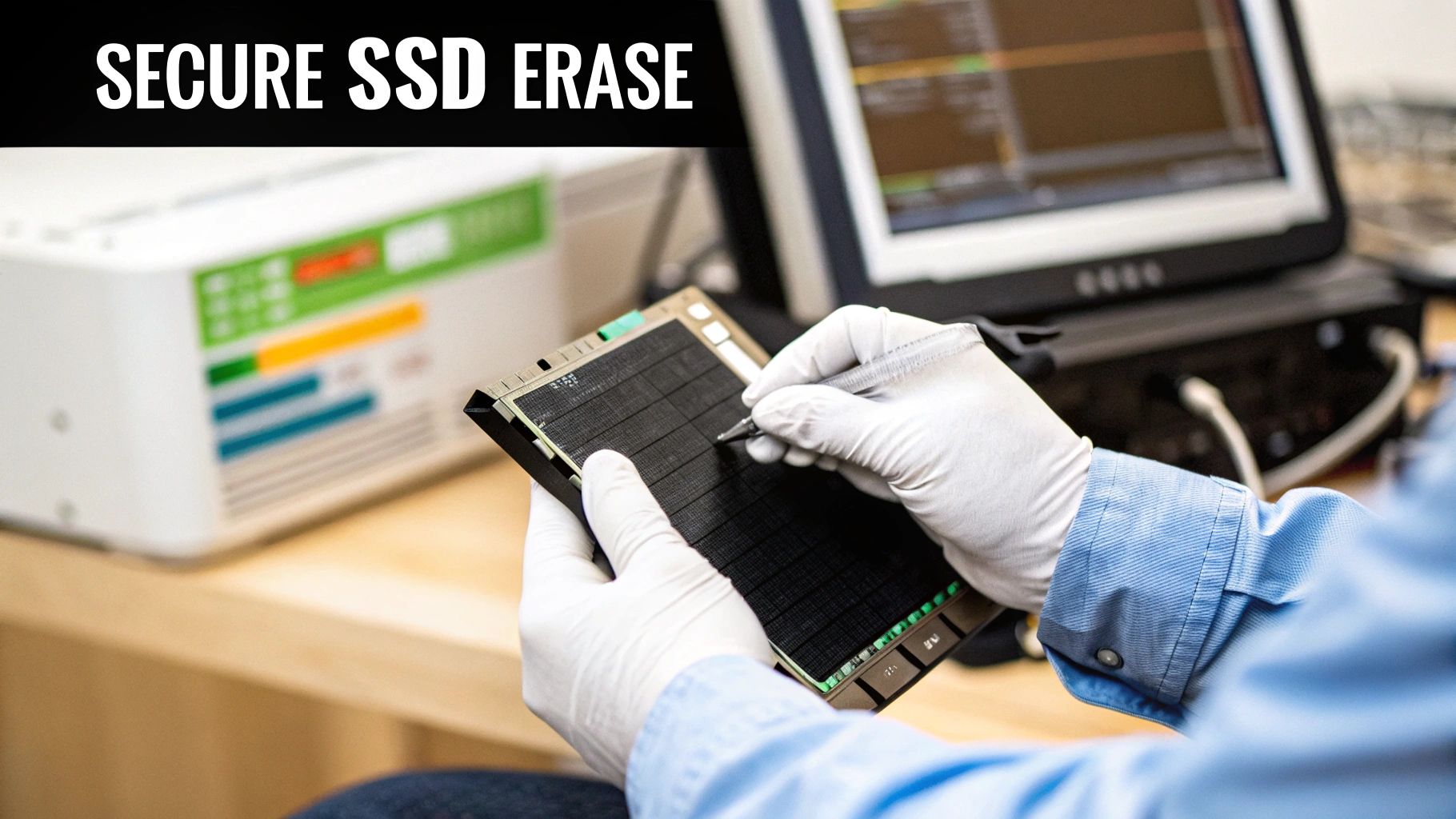How Do You Erase a Computer Hard Drive: A Business Compliance Guide

Erasing a computer hard drive is more than just dragging files to the trash. For any organization serious about data security, it means employing specialized methods to completely sanitize storage media, ensuring sensitive information is irrecoverable. This isn't just an IT best practice—it's a critical component of risk management, regulatory compliance, and protecting your company's intellectual property when IT assets are decommissioned.
Why Secure Data Erasure Is A Business Imperative
Here’s a hard truth: deleting files or reformatting a hard drive creates a dangerous illusion of security.
These common actions don't actually remove the data. They simply delete the pointers that tell the operating system where the files are located. The actual ones and zeros remain on the drive, easily recoverable with off-the-shelf software. For an IT manager, CISO, or compliance officer, this is more than a simple oversight; it’s a massive business risk. A data breach from a carelessly discarded piece of hardware is a real and constant threat.
Picture this all-too-common scenario: a regional law firm upgrades its laptops and sends the old ones to a local recycler. The IT team did a standard format, thinking that was enough. Months later, one of those laptops ends up on a second-hand market, where a tech-savvy buyer recovers confidential client case files. The fallout? A catastrophic breach of attorney-client privilege, steep regulatory fines, and a damaged reputation that takes years to rebuild.
This isn’t just a hypothetical. The consequences of improper data disposal are severe and well-documented:
- Regulatory Fines: Non-compliance with regulations like HIPAA, GDPR, or CCPA can lead to crippling financial penalties. A single drive containing PII could trigger a painful audit and legal battle.
- Brand Damage: A public data breach shatters customer trust and stakeholder confidence. The long-term cost of rebuilding your reputation often dwarfs the initial fines.
- Intellectual Property Loss: Decommissioned drives can be a goldmine of trade secrets, R&D data, financial projections, or client lists. If that information falls into a competitor's hands, the strategic damage can be irreversible.
Beyond Deletion: You Need A Strategy
Secure data erasure shouldn't be treated as a simple IT task. It’s a core part of your corporate risk management strategy. It’s your first line of defense against what’s known as "digital exhaust"—the trail of data left behind on old devices. Having a documented, verifiable process for erasing every single hard drive is the only way to be sure. In fact, it's a primary method for effectively managing digital exhaust to mitigate risk and shielding your organization from liabilities you never saw coming.
The ultimate responsibility of any business is to ensure that when an IT asset reaches its end-of-life, the data on it does too. Anything less is an open invitation for a breach. The question is never if it will happen, but when.
Ultimately, a secure data sanitization program is integral to a comprehensive IT Asset Disposition (ITAD) plan that protects your business from every angle. A proper policy ensures every device—whether it’s being recycled, resold, or redeployed internally—is a clean slate, not a ticking time bomb.
Using Software For Verifiable Data Erasure
When your business is ready to reuse, resell, or donate IT assets, software-based erasure is the only sustainable and compliant path forward. This involves highly specialized software that systematically destroys data by writing patterns of meaningless information over every single sector of a drive. The goal is to make the original data completely, forensically irrecoverable.
This approach is so critical because many common practices are dangerously inadequate. A recent industry report found that a staggering 56% of IT professionals mistakenly believe that just reformatting a drive is enough to permanently remove data. That's a huge misconception that leaves companies incredibly vulnerable.
To truly ensure data is gone for good, you need professional software erasure, which almost always involves multiple overwrite passes according to globally recognized standards.
Choosing The Right Erasure Standard
Not all software erasure methods are created equal. The specific algorithm you choose dictates the level of security and compliance you achieve. For years, the go-to standard for many organizations was the DoD 5220.22-M 3-pass method, but today's standards offer more refined and efficient approaches.
- DoD 5220.22-M (3-Pass): An older but still widely recognized standard. It overwrites data with a specific pattern, its inverse, and then random characters. Consider it a solid baseline for most commercial applications.
- NIST 800-88 Clear: This modern standard involves overwriting data using logical block addressing, essentially blanketing the entire user-addressable area of the drive. It’s an effective method for assets that will remain within your organization's control.
- NIST 800-88 Purge: For highly sensitive information, a more robust method is required. This standard sanitizes data so it cannot be recovered even with advanced laboratory techniques. It often leverages a drive's internal cryptographic erase functions and is a must for high-stakes data disposal.
The infographic below drives home the risks of getting this wrong. Failing to implement a proper erasure strategy can quickly spiral from simple data exposure into serious regulatory fines.
This simple flow shows how one unsecured piece of data can escalate into a significant financial and reputational crisis for any business.
From Erasure To Audit-Proof Documentation
For any business, the real value of professional data wiping software isn't just the erasure itself—it's the verifiable proof it creates. Wiping a drive is one thing, but proving it during an audit is another. You need an immutable record showing the process was completed successfully and according to a specific standard.
This is where a Certificate of Erasure is indispensable. It's a tamper-proof digital document generated for every single drive processed.
A Certificate of Erasure acts as a legal receipt for your data destruction. It contains critical details like the drive's serial number, the erasure standard used, the date and time of completion, and verification results. Without this, you have no way to prove you met your compliance obligations.
This documentation is your key defense in a security audit. It demonstrates a consistent, professional, and fully documented approach to IT asset disposition. If a regulator ever questions what happened to a specific asset, you can produce the certificate and show exactly how its data was sanitized.
Managing Erasure At Scale
For an IT team managing the lifecycle of hundreds or even thousands of devices, efficiency is everything. This is where professional-grade erasure software and services shine. They are designed for this reality, allowing technicians to create bootable USB drives or network boot (PXE) environments to wipe dozens of computers simultaneously without ever having to pull the hard drives.
When evaluating a software solution or service partner, look for:
- Centralized License Management: An easy way to deploy and track software licenses across your entire inventory.
- Automated Reporting: The best tools automatically generate and store Certificates of Erasure in a central database, making them simple to retrieve on demand.
- Hardware Diagnostics: Many platforms also test key hardware components, which is a huge help in sorting out which assets are good enough for resale.
Ultimately, the goal is to weave data erasure seamlessly into your IT asset disposition (ITAD) workflow. The documentation process is closely related to securing a Certificate of Destruction for physically destroyed assets—both provide the essential paper trail for compliance. By adopting a software-based approach, you not only protect your data but also maximize the residual value of your retired IT hardware.
Choosing Physical Destruction For Ultimate Security
Sometimes, erasing a hard drive isn't enough. For drives at their end-of-life, those that are physically damaged, or drives containing data so sensitive that even a 0.001% chance of recovery is an unacceptable risk, physical destruction is the only answer.
This is the final, definitive step in the data lifecycle—the point of no return. It’s a move beyond software that renders the storage media completely useless and its data permanently unrecoverable. For IT managers and compliance officers, this is about absolute certainty.
The two main methods in a professional setting are degaussing and shredding. Each has a specific use case, and knowing the difference is vital for a compliant IT asset disposition (ITAD) strategy. This is the required path for obsolete drives, failing hardware, or anything that once held top-tier intellectual property or sensitive PII.
Degaussing Magnetic Media
Degaussing has been a staple for erasing data from magnetic media like traditional Hard Disk Drives (HDDs) and backup tapes. The process is straightforward: the drive is exposed to a powerful magnetic field, which instantly scrambles the magnetic domains on the platters where the data resides.
This process permanently obliterates the information, making it completely unreadable. The biggest advantage here is speed. A commercial degausser can process up to 1,000 HDDs per hour, making it far more efficient than software wiping for large-scale decommissioning projects. It’s no surprise that industry data from 2025 shows over 70% of organizations in the US and UK still use degaussing for their legacy magnetic media. You can find more insights on the effectiveness of degaussing in 2025.
However, there's a critical limitation for modern IT infrastructure.
Degaussing is completely ineffective on Solid-State Drives (SSDs). SSDs store data on flash memory chips (NAND), which are not magnetic. Applying a degausser to an SSD will likely destroy its controller electronics but will leave the sensitive data on the memory chips perfectly intact.
Because of this, degaussing is a legacy solution. It is perfect for aging inventories of HDDs and tapes but a dangerous liability for modern IT assets.
Industrial Shredding: The Ultimate End-of-Life Solution
When there can be absolutely no doubt that the data is gone forever, industrial shredding is the gold standard. This physical destruction process is exactly what it sounds like: a powerful machine with hardened steel cutters grabs the drive and grinds it into tiny, unrecognizable fragments of metal and plastic.
It is universally effective on all media types:
- Hard Disk Drives (HDDs): The platters are shattered into tiny pieces.
- Solid-State Drives (SSDs): The NAND flash memory chips are pulverized, destroying the data cells.
- Magnetic Tapes and Other Media: All media is reduced to small, mixed-up fragments.
Particle size can be specified based on security requirements, with some high-security shredders reducing drives to fragments just a few millimeters wide, making data reconstruction physically impossible.
Partnering With A Certified Destruction Vendor
Most businesses will not invest in an industrial shredder. The most secure, efficient, and practical approach is to partner with a certified ITAD and e-waste recycling vendor. A reputable partner provides a secure chain of custody from the moment your assets leave your facility.
When you're looking for professional hard drive destruction services, here’s what to look for to ensure you're covered:
- NAID AAA Certification: This is the industry's top certification for secure data destruction. It is your assurance that the vendor follows strict security protocols, including employee background checks and audited processes.
- On-Site and Off-Site Options: Many vendors offer mobile shredding trucks. This allows you to witness the destruction at your own facility, which provides ultimate peace of mind and an unbroken chain of custody.
- A Certificate of Destruction: This is the critical piece of documentation for your audit trail. It’s your legal proof, listing the serial numbers of the destroyed drives and attesting to their permanent destruction.
That certificate closes the loop on the asset's lifecycle. It’s the official record proving you met your due diligence under frameworks like HIPAA or GDPR and that the data is gone for good.
Navigating The Unique Challenges Of Erasing SSDs
Solid-State Drives (SSDs) have revolutionized business computing with incredible speed and reliability. However, when it comes to data erasure, they present significant challenges. The methods perfected for traditional Hard Disk Drives (HDDs)—like multi-pass software overwriting—are not just ineffective on SSDs; they can be counterproductive.
This isn't a minor technicality. It’s a critical security gap that every IT manager and compliance officer needs to understand.
The heart of the issue is how SSDs are engineered. Unlike an HDD that writes data to a specific, predictable location on a platter, an SSD’s controller constantly moves data across its flash memory chips to ensure longevity. This is great for performance, but it creates a huge blind spot for traditional secure erasure software.
This image shows the internal architecture of a modern SSD, with the NAND flash memory chips where data is stored. This design makes old wiping techniques obsolete, as external software cannot precisely control where data is written on these chips.
Why Standard Overwriting Fails On SSDs
Two key features of every SSD make standard software wiping a non-starter: wear-leveling and over-provisioning. These are internal management systems that operate outside of direct user or software control.
- Wear-Leveling: An SSD’s controller constantly moves data around to ensure no single memory cell is overused. When your software attempts to overwrite a file, the controller might simply write that new data to a different physical block, leaving the original, sensitive data perfectly intact but inaccessible to the OS.
- Over-Provisioning: Every SSD has extra memory blocks that are invisible to the operating system. This reserve space is used by the controller for internal tasks like managing wear-leveling and replacing failed cells. Since erasure software cannot access this over-provisioned area, data fragments can easily survive a wipe.
Trying to erase an SSD with traditional overwriting software is like trying to paint a moving wall. You can never be sure you’ve covered every single spot because the target is always shifting without you knowing.
This is a massive compliance risk. If your team is running a DoD 5220.22-M overwrite on an SSD and calling it a day, you have no real way of proving that all data—especially the data in those hidden areas—has been properly sanitized.
The Correct Method: ATA Secure Erase And NVMe Format
So, how do you correctly erase an SSD? The solution is not to fight the drive's controller from the outside but to command the controller to erase itself using protocols built into the drive's firmware.
For any modern drive, the only manufacturer-approved and truly effective methods are:
- ATA Secure Erase: This command is built into the firmware of every modern SATA SSD. When triggered, the drive's controller applies a high-voltage pulse to every NAND memory cell, including those in the over-provisioned space. The process instantly resets the entire drive to its factory state.
- NVMe Format: For newer, faster NVMe SSDs, this is the equivalent command. It instructs the drive's own controller to run a low-level format that completely clears all user data from the media.
These commands can be executed using manufacturer-specific tools (like Samsung Magician or Crucial Storage Executive) or professional third-party data erasure platforms.
The process is extremely fast, often taking only a few seconds. More importantly, it is the only way to reliably sanitize the entire drive and address the unique challenges of wear-leveling and over-provisioning. If you're decommissioning SSDs for reuse or resale, this is the only approach that's truly compliant.
Building A Compliant Data Destruction Policy
Knowing the right software or destruction method to erase a hard drive is essential, but without a formal, documented policy, your organization is exposed to significant risk. An IT Asset Disposition (ITAD) policy transforms individual technical procedures into a consistent, defensible, and audit-proof corporate program.
This policy isn't just about satisfying auditors—it's a practical shield that protects your business. It eliminates ambiguity, standardizes processes, and ensures every employee, from the IT helpdesk to department heads, understands their role in protecting company data when a device reaches its end of life.
Core Components of a Robust ITAD Policy
A strong policy leaves nothing to chance. At its heart, every robust data destruction policy needs a clear, documented process for secure data destruction to ensure organizational alignment and regulatory compliance.
Your policy must define specifics in these key areas:
- Data Classification Levels: Not all data is created equal. Define clear tiers—such as Public, Internal, Confidential, and Restricted—and then mandate a specific erasure or destruction method for each. For instance, a drive from a public kiosk might require a NIST 800-88 Clear, but the drive from the CFO's laptop must be physically shredded. No exceptions.
- Roles and Responsibilities: Who is authorized to handle assets containing sensitive data? Your policy should clearly outline the responsibilities of IT staff, department managers, and any third-party vendors. This creates a clear line of accountability.
- Approved Sanitization Methods: Be explicit about the approved methods for different media types. Mandate ATA Secure Erase for SSDs, a DoD 5220.22-M 3-pass wipe for reusable HDDs, and physical shredding for damaged or highly sensitive drives. Vague language like "drives will be wiped" is a massive red flag for any auditor.
A policy is only as good as its last update. Technology and threats evolve constantly. Your ITAD policy should be a living document, reviewed and updated annually—or whenever new storage technologies are adopted—to ensure it remains effective and enforceable.
Establishing a Defensible Chain of Custody
One of the most critical functions of an ITAD policy is to enforce a strict chain of custody. This is the chronological, documented trail that tracks an asset from the moment it’s decommissioned until its data is verifiably destroyed.
A proper chain of custody log is non-negotiable and must track:
- The asset's serial number and a brief description.
- The name of the individual who took possession of the asset.
- The exact date and time of every transfer.
- The secure location where it’s being stored prior to sanitization.
- The final disposition method (e.g., erasure, shredding) and the date of completion.
- A direct reference to the Certificate of Erasure or Destruction.
This documentation is your best defense in an audit. It proves you have a controlled, repeatable process, not just a haphazard approach.
Avoiding Common Policy Pitfalls
Even with the best intentions, ITAD policies can fail if they are not practical. A common mistake is creating an overly complex policy that is difficult for employees to follow consistently. Another pitfall is failing to secure buy-in from senior leadership, which often means the policy lacks the necessary resources for successful implementation.
Finally, your policy must extend to your partners. When you work with third-party e-waste disposal companies, your policy should mandate that they are NAID AAA certified and require them to provide detailed, serialized Certificates of Destruction. This extends your security framework beyond your own four walls and ensures your compliance standards are upheld throughout the entire disposition lifecycle.
Common Questions About Hard Drive Erasure
Even with a solid data destruction policy, practical questions arise during implementation. For IT managers and compliance officers, the details are critical. Getting them wrong can easily lead to a security gap or a compliance failure.
Here are answers to common questions from businesses on the front lines of IT asset disposition.
How Long Does It Take To Securely Erase A Hard Drive?
This depends on the drive's size, its health, and the erasure method used.
- Software Wiping (e.g., DoD 3-Pass): This is the most time-consuming option. Wiping a modern 1TB HDD with a 3-pass method can take anywhere from 8 to 24 hours. It is thorough but can create significant bottlenecks in large-scale projects.
- ATA Secure Erase (for SSDs): This method is incredibly fast. The command instructs the drive's own controller to reset all flash memory cells simultaneously. The process is typically completed in under a minute, regardless of drive capacity.
- Physical Destruction: Shredding is nearly instantaneous. Once a drive enters the shredder, it is destroyed in seconds, making it the most efficient method for handling large volumes of end-of-life media.
Do I Need The Original Computer To Erase The Drive?
No. While you can run erasure software on a live machine, it is often inefficient.
Most professional IT teams and service providers use dedicated multi-bay hard drive docks or sanitization appliances connected to a single workstation. This setup allows a technician to wipe multiple HDDs and SSDs simultaneously, streamlining the workflow. It is especially useful for processing drives from non-functional computers or servers, allowing data to be sanitized without needing the original hardware.
The key takeaway is that the data resides on the drive, not the computer. As long as you can connect that drive to power and a data interface like SATA or USB, it can be sanitized with the proper tools.
What Is The Best Method For A Damaged Hard Drive?
If a hard drive is physically damaged—it has been dropped, will not spin up, or is making clicking sounds—software erasure is not an option. Erasure software must be able to read and write to every sector to verify the wipe, which is impossible on a damaged drive.
In this scenario, physical destruction is the only acceptable and secure option. A failing or non-functional drive still contains its data. Attempting a software wipe creates a false sense of security. The only way to guarantee data is unrecoverable is to have the drive professionally shredded.
Can I Just Smash The Hard Drive With A Hammer?
While it may seem effective, destroying a hard drive with a hammer is not a secure or compliant method of data destruction. This approach is dangerously unreliable and leaves your business exposed.
The magnetic platters inside an HDD are surprisingly durable and can survive blunt force trauma. Large, data-rich fragments can easily be left behind, which could be recovered in a lab. For a destruction method to be compliant, it must be verifiable and repeatable. A hammer offers neither.
Professional shredding, in contrast, reduces the drive to a specific particle size, ensuring no data can ever be reassembled. It also provides a Certificate of Destruction for your audit trail. That's the critical difference between ad-hoc destruction and a secure, compliant process, a key consideration when selecting professional computer disposal services for your business.
At Atlanta Computer Recycling, we understand that navigating the complexities of data destruction is a critical business responsibility. We provide certified, compliant, and documented data erasure and physical destruction services tailored for businesses, healthcare organizations, and government agencies across the Atlanta metro area. Let us help you build a secure and auditable ITAD program. Contact us today to learn more at https://atlantacomputerrecycling.com.


